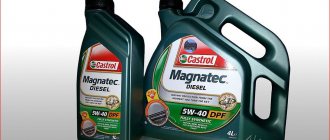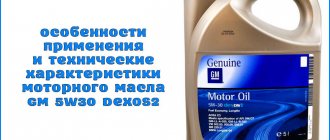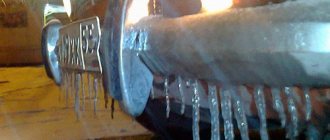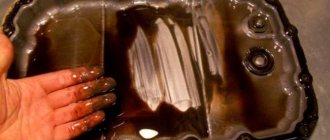Every driver periodically asks himself the question: “Why does the engine of his car eat oil?” When answering this question, it is necessary to remember that the very principle of operation of an internal combustion engine (ICE) provides for the presence of a large number of friction units that require constant lubrication. In its absence, there can be no talk of any motor resource of the power unit.
Developers and manufacturers of automobile internal combustion engines are constantly working to improve the lubrication systems of automobile engines. Currently, it is considered normal if oil consumption is 0.1...0.3% of total fuel consumption per unit mileage. Exceeding this value indicates wear of engine parts or the appearance of malfunctions in its lubrication system.
There are many reasons why an engine eats oil. They have long been systematized by type of fault, and therefore diagnosing them is not difficult for an experienced car owner.
Reasons for oil consumption
Leading specialists from various companies, such as Castrol, identify a whole system of reasons due to which increased consumption occurs or the oil level in the engine decreases. All this directly affects the operation of the engine, and lubricant consumption is the only parameter that the motorist himself can evaluate. It will be enough for him to take the measurement himself, using a probe specially designed for this.
Quality
Oil consumption mainly depends on its quality. And experts in this field advise assessing the quality of a lubricant by its ability to neutralize acidic elements formed from fuel combustion. Also of no small importance is the anti-corrosion activity of the lubricant and how successfully the motor oil performs its main functions, which include the ability to wash and disperse various components. But the most important thing is the quality assessment, which allows you to determine how much it minimizes and prevents wear and tear on engine parts.
Waste expense
An important topic that deserves consideration is the topic of oil consumption due to waste. In other words, this term means the direct entry of oil into the combustion chamber and its subsequent combustion simultaneously with the fuel. And you should know that in every internal combustion engine, during operation, partial consumption of this lubricant occurs, and this is due to the operation of the unit and the specifics of the device.
Let's take the following example. In the cylinder-piston group, the lubricant serves to directly reduce friction between moving surfaces. The oil also acts as a coolant for the parts and ensures a proper seal between them. It is applied to the surface of the cylinder and piston rings, and during the power stroke, the oil scraper rings remove its excess. They leave a thin oil film, which, along with gasoline or other fuel, burns out in each cycle of operation of the car engine.
Engine oil waste itself can be easy to diagnose. It produces bluish smoke in the exhaust, which is not observed when burning gasoline (of course, high-quality gasoline). But this should not be confused with black smoke, which means the injection is not working properly. Another symptom of its combustion is an oily black edge that forms on the edges of the exhaust pipe.
It is much more difficult to understand the cause of oil waste. This cannot be done without opening the engine, although there are a number of relatively simple and inexpensive methods of dealing with waste.
First of all, you will need to determine how much oil should burn in the engine. In other words, what lubricant consumption is intended for a particular engine.
The second is the knowledge that the amount of burned oil depends on the operating mode of the car engine. That is, if the driver often uses high speeds when driving, then much more oil will burn in this engine. This, in fact, is an ordinary law of physics - the higher the speed, the higher the temperature of the oil and engine becomes.
As for the consumption rate in this case, it is taken into account in the specifications of a particular car production. And each specific modification of the engine is necessarily reflected in the documentation for the car.
Coking of rings
The formation of soot and deposits on the piston rings leads to reduced ring mobility. This phenomenon is also commonly called piston ring sticking. If the rings are stuck (lost the ability to move), then there is no effective seal in the cylinder. The result is a breakthrough of gases from the combustion chamber, as well as the entry of engine oil into the combustion chamber.
We also recommend reading the article about methods for decarbonizing an engine. From this article you will learn how to decarbonize piston rings yourself and remove deposits from the combustion chamber.
The occurrence of rings leads to a decrease in compression, excessive consumption of lubricant, and smoking of a diesel or gasoline internal combustion engine. The malfunction can be eliminated either by disassembling the engine and mechanically cleaning it, or by using various chemicals to decarbonize the piston rings.
Why does it burn?
“Why does oil burn in general?” an inquisitive reader may ask. There are so-called main reasons due to which increased combustion occurs.
First of all, combustion can occur due to the fact that the wrong type is poured into the engine. For example, oil of too low viscosity tends to burn out according to the engine, and lubricant of too high viscosity tends to accumulate on the internal walls of the automobile unit. In both cases, significant oil losses will be detected.
The second reason may be oil reflective caps that have worn out over time. And an experienced driver should know that the cause of this very wear is a sharp temperature change or, again, unsuitable engine oil.
And third, often worn oil scraper rings cause combustion. Ideally, to solve this problem, the rings should be replaced and the engine overhauled. Although some experts advise decarbonizing the rings.
Another reason is wear on the internal surfaces of the cylinders or, in other words, wear.
Finally, high crankcase gas pressure or compressor failure causes oil combustion.
And so, friends, what is the mistake when checking the oil level?
Firstly, before checking the engine oil, you must warm up the engine to operating temperature, otherwise the “cold” level of this oil in the engine, which you see on the oil dipstick, will be incorrect. Accordingly, if you incorrectly interpret the results of measuring the oil level in the engine in advance, you can make a mistake, namely: - add and pour oil in vain, or simply do not add oil to an engine in which the lubricating fluid is at a minimum.
Also remember that after the engine has warmed up, you should not immediately check the oil level. Turn off the engine and wait about 5 minutes until the oil drains from the engine components. If you do this earlier, you may mistakenly miscalculate that the oil in the engine is at its minimum value.
And so about the main thing, take oil measurements every 1000 kilometers. If necessary, add oil to the maximum mark indicated on the dipstick. Then, after running 10 or 15 thousand km, check by the amount of oil remaining in the bottle how much fluid you added to the engine during this same mileage interval.
In particular, we advise you, dear motorists, to carefully study the operating manual for your car, where the car manufacturer must indicate the permissible maximum level of engine oil consumption. Let us repeat once again for those who do not remember that currently many automakers indicate in the car’s operating manual that oil consumption of 1 liter per 1000 km is an acceptable norm. If your car consumes more oil than indicated in the technical specifications, then most likely there is either an engine oil leak or design problems within the power unit itself. In this case, you must conduct a comprehensive engine diagnostics at a technical auto center. Good luck to all dear motorists!
High oil consumption
Video about why a car may have increased oil consumption:
What is a high expense? Let's try to answer the question: is a liter of oil per 1000 kilometers a lot or a little? The answer is simple and individual. While this is the norm for V6 or V8 engines, the engine of in-line small cars should not consume so much lubricant. As mentioned above, it all depends on the specific engine. And do not forget that any engine, even the newest one, will take away this same oil. He works on it, and it shouldn’t be any other way.
Interestingly, experienced drivers recommend simply adding oil to a fairly worn engine rather than making major repairs. This does not always help, and as mentioned above, there are many reasons for high fuel consumption.
The following factors can also affect lubricant consumption:
- as the condition of the gaps in the cylinder-piston group (often this factor is associated with natural wear of parts, leading to greater oil consumption);
- crankcase pressure;
- correct adjustment and settings of the engine;
- violation of tightness at connection points (meaning those points that have either rubber hoses or seals);
- driving style;
- correct selection of oil in accordance with a specific engine;
- oil quality;
- compliance with replacement deadlines and much more.
Oil leak
What should a driver do if he discovers a leak? It would seem that every experienced motorist knows the answer to this question: you need to change gaskets, seals, and the like. And oil can leak from the engine in the following places: from the valve cover gasket, from the cylinder head gasket, from the crankshaft and camshaft seals, from the rear crankshaft oil seal and the gasket located under the oil filter.
Valve cover gasket
If oil is leaking from the valve cover gasket located on top of the engine, lubricant leaks will be clearly visible on the outer side walls of the unit. A lot of oil cannot leak through this very gasket, but you still need to take care of the tightness.
Cylinder head gasket
If oil is leaking from the head gasket, also located on top of the engine, it will leak out. You should know that on V-shaped engines there are two of them, as well as, strictly speaking, cylinder heads.
Cylinder head gasket on cylinder block
Gaskets can be damaged in various places, but oil can also leak into the cooling system if the part of the gasket that is located between the cooling system holes and the working cylinders is punctured. And in this case, the engine itself may appear dry, and oil leaks will be more difficult to detect. But you can identify this problem by the coolant, which becomes cloudy and changes color. And the oil in the engine will even begin to foam and this same foam can be seen on the inner surface of the neck cap through which lubricant is poured into the engine.
Problems with the cylinder head gasket are resolved immediately, without waiting a second, since all this can lead to damage to the engine itself.
Oil seals
Opening the hood, such a leak will not be easy to notice. But stains on the inner surface of the crankcase protection and smudges from below may indicate a problem. And this leak, like the one described above, should be removed immediately.
Unscrew the oil filter
Oil pan gasket
It can only be seen by using a jack and removing the protection. And at the next oil change, it would be useful to check for such a problem.
Rear crankshaft oil seal
It is located directly at the crankshaft entrance to the gearbox and in most cases must be replaced by removing the gearbox. It is impossible to see him differently. Although a leak can be diagnosed by smudges found in the lower part of the engine.
Determining the reasons for high oil consumption
- Determining the color of exhaust gases.
- Identifying the location of the oil leak.
- Checking the operation of the crankcase ventilation.
- Removing the cylinder head and checking its condition.
Exhaust color
This procedure is best performed with an assistant. One person should press the gas pedal until the engine speed reaches about 3000. The second person should look at the smoke of the exhaust gases. On diesel engines, when you press the gas sharply, black smoke may appear, which disappears after you release the gas pedal. Blue smoke, which increases with engine speed, indicates oil penetration into the cylinders through rings, caps or gaskets and requires replacement. If the exhaust gases are colorless, then the rings and caps are working properly.
Finding oil leaks
A car with large leaks usually leaves oil stains where it is parked and needs urgent repairs. Minor leaks only occur when the engine is running under load, so no marks are left on the ground when parked. There should be no oil spots on the outer surfaces of a serviceable engine. If there is an oil or wet spot, there is an oil leak.
To clarify the leak, you need to start the engine and let it idle so that it reaches operating parameters, and then conduct a visual inspection of the suspected area again.
If an increase in oil is not visible at this point, then you need to gradually increase the engine speed to maximum values for a minute, and carefully watch the control point. If this procedure does not help identify the leak, then you need to drive the car 20 kilometers, while periodically increasing the speed. At this rate, the pressure in the cylinder is much greater than during normal operation, and therefore the volume of gases entering the crankcase is much greater. If, after checking, the control area becomes more oily, then the problem lies in the crankcase ventilation system and damage to the gasket or poor tightening of it.
Crankcase ventilation control
To check the ventilation, you need to loosen the clamps securing the ventilation valve and remove it. Next, you need to blow out the ventilation valve with your mouth or a compressor. If the valve is working properly, air should flow in one direction, and then with force; air should not flow in the other direction.
Next, remove and blow out the ventilation hoses and check the pipes. They can become clogged with sediment or dirt.
Checking the cylinder head gasket
This check is carried out after identifying bluish exhaust gases. A serviceable cylinder head gasket should not have any damage in the form of ruptures, cracks or burnouts. But if the gasket is in good condition, then it must be replaced, since it is used once. If it is damaged, then it is necessary to check the flatness of the cylinder head, since it could be warped as a result of excessive heating of the engine.
Viscosity index
The choice of oil is made in accordance with its viscosity index.
There is a table of viscosity markings. The oil is labeled as follows. The winter viscosity mark contains the Latin letter W and a number next to it, for example, 5W, 10 W, 30 W. The smaller the number next to the letter, the thinner the oil will be when the temperature drops, which will make the engine start easily. Summer markings include only numbers, and the higher they are, the more viscous the oil will be in the heat. The marking looks like this:
- about 0 °C: 5W-30 10W-30 10W-40 20W-50;
- from 18 °C: 5W-30 10W-30 10W-40;
- below 18 °C: 5W-30.
You should select oil based on the manufacturer’s instructions. An exception may be an engine that has undergone major transformations.
In addition, the oil is marked for a gasoline engine with the mark A and for a diesel engine with the letter E. Three types of oil can be poured into the engine:
- economical;
- universal;
- with high performance.
Thus, it turns out that A1 is an economical oil that is used in gasoline engines. Further by analogy. It is important to know that oil and fuel consumption depends on the viscosity index. Motor oils directly affect the following factors:
- ease of starting the car, regardless of weather conditions;
- the thickness of the film formed, which guarantees the reliability of separation of rubbing surfaces;
- Engine efficiency;
- motor power (the dependence is explained by friction losses);
- the amount of precipitation that forms in the lubricant.










